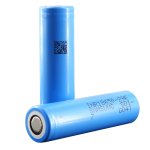The discharge rate of 18650 batteries, also known as the rate at which a battery can release its stored energy, is a critical factor in determining its usefulness in various applications. In general, the discharge rate of a battery is expressed in terms of a C-rating, where C is a multiplier of the battery's nominal capacity. For example, a 1C-rated 18650 battery with a nominal capacity of 2000mAh can discharge at a rate of 2000mA, or 2A.
However, not all 18650 batteries are created equal when it comes to their discharge rates. Some batteries are designed for high-discharge applications, such as power tools or electric vehicles, while others are meant for low-drain devices like flashlights or remote controls. Understanding the discharge rate of 18650 batteries is crucial to selecting the right battery for a particular application.
The discharge rate of an 18650 battery is closely related to its internal resistance. The higher the internal resistance of a battery, the more voltage drop occurs when a current is drawn from it. This voltage drop can lead to a loss of power, reduced performance, and even damage to the battery or device. Therefore, it is essential to select an 18650 battery with low internal resistance for high-discharge applications.
In addition to internal resistance, the chemistry of the battery also plays a crucial role in determining its discharge rate. Lithium-ion batteries, which are the most common type of 18650 battery, are designed to deliver high currents over short periods, making them suitable for high-drain applications. However, they can also suffer from reduced performance and capacity if they are discharged too quickly.
To avoid these issues, it is important to select an 18650 battery with a discharge rate that matches the specific requirements of the application. For example, a power tool may require a battery with a discharge rate of 10C or higher, while a flashlight may only need a battery with a discharge rate of 1C or less.
It is also worth noting that the discharge rate of an 18650 battery can be affected by external factors such as temperature and age. Batteries that are subjected to high temperatures or frequent deep discharges may experience a reduction in their discharge rate over time. Similarly, older batteries may not be able to deliver the same level of performance as newer ones, even if they have the same nominal capacity and discharge rate.
In conclusion, the discharge rate of 18650 batteries is a crucial factor in determining their usefulness in various applications. When selecting an 18650 battery, it is important to consider its internal resistance, chemistry, and specific discharge rate requirements. By choosing the right battery for the job, users can ensure optimal performance, longer battery life, and improved safety.
However, not all 18650 batteries are created equal when it comes to their discharge rates. Some batteries are designed for high-discharge applications, such as power tools or electric vehicles, while others are meant for low-drain devices like flashlights or remote controls. Understanding the discharge rate of 18650 batteries is crucial to selecting the right battery for a particular application.
The discharge rate of an 18650 battery is closely related to its internal resistance. The higher the internal resistance of a battery, the more voltage drop occurs when a current is drawn from it. This voltage drop can lead to a loss of power, reduced performance, and even damage to the battery or device. Therefore, it is essential to select an 18650 battery with low internal resistance for high-discharge applications.
In addition to internal resistance, the chemistry of the battery also plays a crucial role in determining its discharge rate. Lithium-ion batteries, which are the most common type of 18650 battery, are designed to deliver high currents over short periods, making them suitable for high-drain applications. However, they can also suffer from reduced performance and capacity if they are discharged too quickly.
To avoid these issues, it is important to select an 18650 battery with a discharge rate that matches the specific requirements of the application. For example, a power tool may require a battery with a discharge rate of 10C or higher, while a flashlight may only need a battery with a discharge rate of 1C or less.
It is also worth noting that the discharge rate of an 18650 battery can be affected by external factors such as temperature and age. Batteries that are subjected to high temperatures or frequent deep discharges may experience a reduction in their discharge rate over time. Similarly, older batteries may not be able to deliver the same level of performance as newer ones, even if they have the same nominal capacity and discharge rate.
In conclusion, the discharge rate of 18650 batteries is a crucial factor in determining their usefulness in various applications. When selecting an 18650 battery, it is important to consider its internal resistance, chemistry, and specific discharge rate requirements. By choosing the right battery for the job, users can ensure optimal performance, longer battery life, and improved safety.

